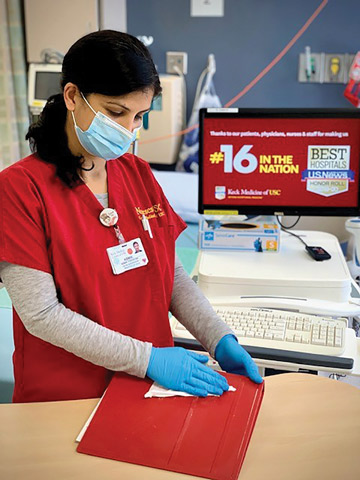As soon as patients are wheeled out of ORs, your surgical team jumps into action. They wipe down and disinfect surfaces, thoroughly mop every square inch of floor space, change the linens and restock critical supplies — and they do it all as fast as possible because time is money in high-volume facilities.
Safety and speed aren’t mutually exclusive when it comes to turning over rooms between cases, and both are essential components of quality outpatient care. While room turnovers may not be the most glamorous task your staff performs, there’s no doubt it’s one of the most important. It’s also one of the most difficult. Throughout my career, it’s been a struggle to perfect a system for quickly and effectively preparing an OR for the next patient. Numerous variables must be managed, but three common factors have helped my teams achieve speedy room turnovers:
• Teamwork. Every member of the surgical team has to be responsible for cleaning during room turnovers. We designate roles to various staff members –– each person has specific areas they are responsible for cleaning. For example, one person is in charge of ensuring computer keyboards, video monitors and the whiteboard are wiped down before the next patient enters the room. Other team members clean the surgical lights, table surface, countertops and so on. The assignments will vary from facility to facility, but the important aspect is to have a system in place to ensure all areas are covered and staff members don’t reclean spots that have already been treated.
From an infection prevention standpoint, proper surface disinfection is crucial. Although using cleaning agents with faster dry times helps make room turnovers more efficient, sometimes that’s not an option. Make sure staff is informed on the specific dry times of the agent your facility is currently using.
• Communication. You know the turnover team is communicating well when everyone is aligned to the same objective: fast and thorough cleaning. Remind teams and individual employees to communicate with each other throughout the entire turnover process to ensure the room is in order and fully supplied. If a regular member of the turnaround team is absent from work or unable to complete their task, communicate that to the team as soon as possible. That way, they can make adjustments to ensure other team members pick up the slack and rooms will be properly cleaned.
Finding solutions to common room cleaning issues often boils down to effective communication. At my previous facility, constant staff turnover resulted in inadequate staffing levels. In fact, only one environmental cleaning staff member was responsible for turning over five ORs. After a room was turned over, I would sometimes still see blood on the floor.
I got infection control and perioperative management involved, formulated a process improvement plan and presented the situation to the leadership team. We held numerous meetings and even hired an outside consultant to help get everyone on the same page. It took a while, but that facility eventually improved the quality of its room turnovers. That experience showed me inefficient processes and protocols can be changed with clear communication.
• Collaboration. Conduct periodic audits of the cleaning process to see if anything is being missed or to identify areas for improvement. Take a proactive role in enhancing the turnover process to avoid placing the entire responsibility on surgical team members and infection preventionists.
Involve representatives from various departments — nursing, anesthesia, infection prevention — in creating a cleaning protocol because each professional has a different perspective based on their role and experience. By giving everyone a say in the process, the challenges and needs are clearer to everyone. Don’t forget to include surgeons in this process — especially when major changes occur. They’re usually in and out of the OR, so they don’t see what happens between cases. But they need to understand the efforts your team makes in ensuring efficient room turnovers and understand how they can contribute. For instance, their willingness to remove waste from the sterile field after procedures will expedite the cleaning process, and the next case will start sooner and their next patient won’t be kept waiting.
.svg?sfvrsn=be606e78_3)

.svg?sfvrsn=56b2f850_5)